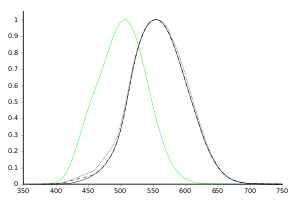Definition and Explanation of Candela
– The candela is the unit of luminous intensity in the International System of Units (SI).
– It measures luminous power per unit solid angle emitted by a light source in a particular direction.
– Luminous intensity is analogous to radiant intensity, but each wavelength’s contribution is weighted by the luminous efficiency function.
– The luminous efficiency function represents the sensitivity of the human eye to different wavelengths.
– The candela is equivalent to the luminous efficacy of monochromatic radiation of frequency 540×10^12 Hz.
– The frequency chosen for the candela is in the visible spectrum near green, around 555 nanometers.
– The human eye is most sensitive to this frequency when adapted for bright conditions.
– Photopic vision, dominant in bright conditions, determines the visual perception of luminous intensity.
– The luminous intensity for light of a specific wavelength is given by the product of the luminous efficiency function and the radiant intensity.
– To obtain the total luminous intensity, integration over the spectrum of wavelengths is necessary.
Examples of Candela
– A common candle emits light with approximately 1 candela luminous intensity.
– A 25W compact fluorescent light bulb radiates around 1700 lumens, resulting in an intensity of 135 candela if emitted equally in all directions.
– Focusing the same light bulb into a 20° beam increases the intensity to around 18,000 candela within the beam.
History of Candela
– Prior to 1948, various standards for luminous intensity were in use, such as candlepower and the Hefnerkerze.
– Jules Violle proposed a standard based on the light emitted by 1cm of platinum at its melting point, called the violle.
– The violle was challenging to implement due to impurities affecting emissivity and melting point.
– In 1937, a new candle based on a black body radiator was proposed and ratified as the candela in 1948.
– The 16thCGPM in 1979 adopted a new definition of the candela based on monochromatic radiation of frequency 540×10^12 Hz.
– The 26th General Conference on Weights and Measures (CGPM) redefined the candela in 2018.
– The new definition, effective from 20 May 2019, is based on the fixed numerical value of the luminous efficacy of monochromatic radiation.
– The candela remains a base unit of the SI system, defined in terms of the second and the watt.
– The luminous efficiency function is not uniquely specified and must be selected to fully define the candela.
Relationships between Luminous Intensity, Luminous Flux, and Illuminance
– Luminous intensity is measured in candelas (cd).
– Luminous flux is the total amount of light emitted by a source and is measured in lumens (lm).
– The relationship between luminous intensity and luminous flux can be calculated using the formula: Φv = Iv * 2π * [1 – cos(A/2)], where A is the radiation angle of the lamp.
– A lamp that emits 590 cd with a radiation angle of 40° emits approximately 224 lumens.
– If a source emits light uniformly in all directions, the luminous flux can be found by multiplying the intensity by 4π. For example, a uniform 1 candela source emits 12.6 lumens.
SI Multiples and Candlepower Definition
– The candela can be modified by adding a metric prefix to multiply it by a power of 10.
– For example, the millicandela (mcd) is equal to 10 candela.
– Candlepower is a term used to describe the luminous intensity of a light source.
– It is defined as the intensity of a standard candle.
– Candlepower is measured in candelas.
– The term ‘candlepower’ is sometimes used interchangeably with ‘luminous intensity.’ Source: https://en.wikipedia.org/wiki/Candela
The candela (/kænˈdɛlə/ or /kænˈdiːlə/; symbol: cd) is the unit of luminous intensity in the International System of Units (SI). It measures luminous power per unit solid angle emitted by a light source in a particular direction. Luminous intensity is analogous to radiant intensity, but instead of simply adding up the contributions of every wavelength of light in the source's spectrum, the contribution of each wavelength is weighted by the luminous efficiency function, the model of the sensitivity of the human eye to different wavelengths, standardized by the CIE and ISO. A common wax candle emits light with a luminous intensity of roughly one candela. If emission in some directions is blocked by an opaque barrier, the emission would still be approximately one candela in the directions that are not obscured.
| candela | |
|---|---|
 | |
| General information | |
| Unit system | SI |
| Unit of | luminous intensity |
| Symbol | cd |
| Conversions | |
| 1 cd in ... | ... is equal to ... |
| international candles | ≈ 1.02 cp |
| Hefner Kerze | ≈ 1.11 HK |
The word candela is Latin for candle. The old name "candle" is still sometimes used, as in foot-candle and the modern definition of candlepower.
